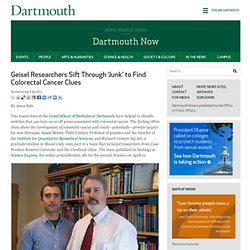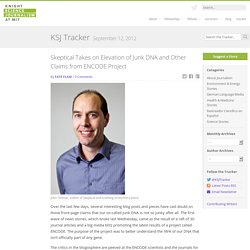

Salk Scientists discover "hidden" code in DNA evolves more rapidly than genetic code. LA JOLLA, CA—A "hidden" code linked to the DNA of plants allows them to develop and pass down new biological traits far more rapidly than previously thought, according to the findings of a groundbreaking study by researchers at the Salk Institute for Biological Studies.

Geisel Researchers Sift Through ‘Junk’ to Find Colorectal Cancer Clues By Amos Esty Two researchers at the Geisel School of Medicine at Dartmouth have helped to identify switches that can turn on or off genes associated with colorectal cancer.

The finding offers clues about the development of colorectal cancer and could—potentially—provide targets for new therapies. Jason Moore, Third Century Professor of genetics and the director of the Institute for Quantitative Biomedical Sciences, and Richard Cowper-Sal.lari, a graduate student in Moore’s lab, were part of a team that included researchers from Case Western Reserve University and the Cleveland Clinic. The team published its findings in Science Express, the online prepublication site for the journal Science, on April 12. Many studies of cancer and other diseases have looked for genetic variations that lead to disease. The researchers looked at specific sections of noncoding DNA in nine colorectal cancer samples and three samples of healthy colon tissue.
Yale Researchers Find "Junk DNA" May Have Triggered Key Evolutionary Changes in Human Thumb and Foot. A rapidly evolving sequence from the human genome drives gene activity in the developing thumb, wrist and ankle of mouse embryos. A high resolution image is available for download. Out of the 3 billion genetic letters that spell out the human genome, Yale scientists have found a handful that may have contributed to the evolutionary changes in human limbs that enabled us to manipulate tools and walk upright. Results from a comparative analysis of the human, chimpanzee, rhesus macaque and other genomes reported in the journal Science suggest our evolution may have been driven not only by sequence changes in genes, but by changes in areas of the genome once thought of as “junk DNA.”
Those changes activated genes in primordial thumb and big toe in a developing mouse embryo, the researchers found. An indication of their biological importance, many of these non-coding sequences have remained similar, or “conserved,” even across distantly related vertebrate species such as chickens and humans. Newsroom - "Junk DNA" Defines Differences Between Humans and Chimps. Research Characterizes Important Genetic Variation Between the Species Posted October 25, 2011 | Atlanta, GA For years, scientists believed the vast phenotypic differences between humans and chimpanzees would be easily explained – the two species must have significantly different genetic makeups.

However, when their genomes were later sequenced, researchers were surprised to learn that the DNA sequences of human and chimpanzee genes are nearly identical. What then is responsible for the many morphological and behavioral differences between the two species? Researchers at the Georgia Institute of Technology have now determined that the insertion and deletion of large pieces of DNA near genes are highly variable between humans and chimpanzees and may account for major differences between the two species.
Click image to enlarge. Skeptical Takes on Elevation of Junk DNA and Other Claims from ENCODE Project. John Timmer, author of skeptical and scathing arstechnica piece Over the last few days, several interesting blog posts and pieces have cast doubt on those front-page claims that our so-called junk DNA is not so junky after all.

What makes you unique? Not genes so much as surrounding sequences, says Stanford study. Michael Snyder The key to human individuality may lie not in our genes, but in the sequences that surround and control them, according to new research by scientists at the Stanford University School of Medicine and Yale University. The interaction of those sequences with a class of key proteins, called transcription factors, can vary significantly between two people and are likely to affect our appearance, our development and even our predisposition to certain diseases, the study found. The discovery suggests that researchers focusing exclusively on genes to learn what makes people different from one another have been looking in the wrong place.
“We are rapidly entering a time when nearly anyone can have his or her genome sequenced,” said Michael Snyder, PhD, professor and chair of genetics at Stanford. Most of what you read was wrong: how press releases rewrote scientific history. This week, the ENCODE project released the results of its latest attempt to catalog all the activities associated with the human genome.

Although we've had the sequence of bases that comprise the genome for over a decade, there were still many questions about what a lot of those bases do when inside a cell. ENCODE is a large consortium of labs dedicated to helping sort that out by identifying everything they can about the genome: what proteins stick to it and where, which pieces interact, what bases pick up chemical modifications, and so on. What the studies can't generally do, however, is figure out the biological consequences of these activities, which will require additional work. Yet the third sentence of the lead ENCODE paper contains an eye-catching figure that ended up being reported widely: "These data enabled us to assign biochemical functions for 80 percent of the genome.
" This was more than a matter of semantics. What we know about DNA, and when we knew it.